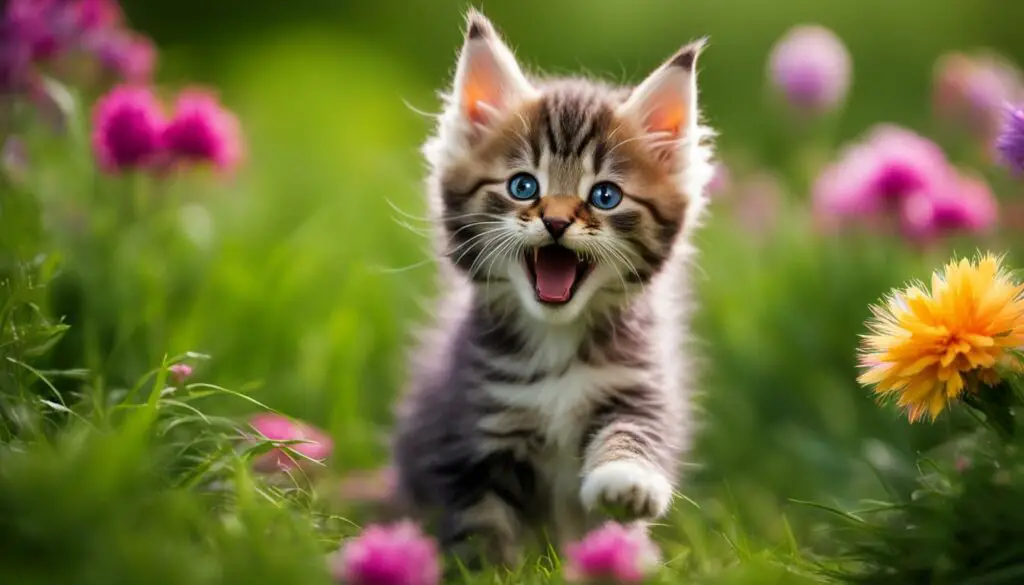Growing up with kittens is an incredibly joyous experience. Their playful antics and boundless energy can bring endless smiles to our faces. One behavior that often captures our attention is when kittens growl while playing with their toys. It’s not only adorable but also a natural expression of their playful nature. In this guide, I will explore the reasons behind this behavior and provide valuable insights on how to ensure a delightful play experience for both you and your kitten.
Key Takeaways:
- Growling while playing with toys is a normal and playful behavior in kittens.
- Understanding this behavior can help create a positive play experience for both the kitten and the owner.
- Play is crucial for a kitten’s mental and physical health, helping to channel their hunting instincts and develop important social skills.
- Recognize the signs of play-induced overstimulation to avoid any potential harm to yourself or other animals.
- Providing a variety of toys and engaging in structured play therapy can help prevent and correct play-induced overstimulation.
The Importance of Play for Kittens
Play is an essential aspect of a kitten’s life, contributing to their overall physical and mental well-being. It not only provides them with entertainment but also helps channel their natural instincts, such as hunting and pouncing. Engaging in regular play sessions with kittens can help manage their behavior, including any signs of aggression that may arise during play with toys.
Playing with toys allows kittens to develop important social skills and learn appropriate boundaries. It gives them an opportunity to practice their hunting skills, encourages physical exercise, and stimulates their cognitive abilities. By providing interactive toys that mimic prey movements, such as fishing pole toys, kittens can engage in active play and satisfy their innate hunting instincts.
Furthermore, play can help prevent boredom and provide an outlet for a kitten’s energy. Regular play sessions can reduce the likelihood of destructive behavior or excessive rough play. By offering a variety of toys and rotating them regularly, kittens remain mentally stimulated and less likely to become bored with their surroundings.
It is important to note that not all play behavior is aggressive or indicative of overstimulation. Kittens may occasionally growl or pounce forcefully during play, which is normal. However, if a kitten consistently displays aggressive behavior, such as excessive growling or biting during play, it is essential to address this behavior and redirect it in a positive way.
Table: Benefits of Play for Kittens
| Benefits | Explanation |
|---|---|
| Development of Social Skills | Playing with toys allows kittens to learn appropriate boundaries and interaction with humans. |
| Exercise and Energy Outlet | Regular play sessions help kittens burn off excess energy and prevent destructive behavior. |
| Mental Stimulation | Engaging in play stimulates a kitten’s cognitive abilities and prevents boredom. |
| Instinctual Behaviors | Playing with interactive toys satisfies a kitten’s natural hunting instincts and prey drive. |
By understanding the importance of play for kittens and providing them with appropriate toys and play opportunities, owners can ensure a positive and enriching experience for their furry friends. Creating a stimulating and engaging environment for play helps foster healthy play behavior and strengthens the bond between kittens and their owners.
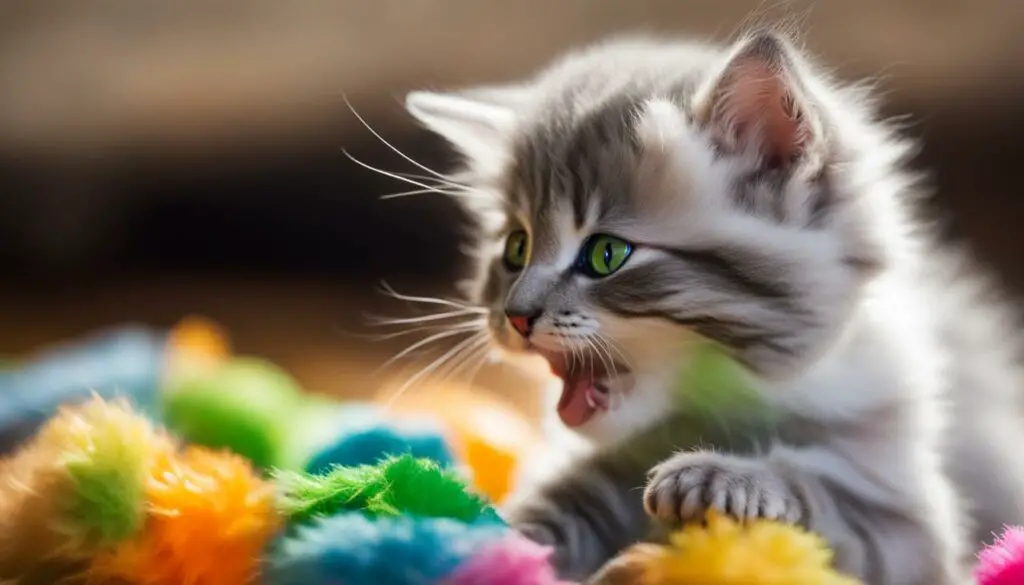
Signs of Play-Induced Overstimulation
During playtime, kittens may sometimes become overstimulated, which can lead to behaviors such as ankle grabbing, scratching, or biting. It’s important to recognize the signs of overstimulation to ensure the safety and well-being of both the kitten and the owner. By understanding these signs, you can take appropriate measures to soothe and redirect your growling kitten’s behavior.
One of the key signs of play-induced overstimulation is an increase in growling. While growling can be a normal part of play for kittens, excessive or intense growling may indicate that the kitten is becoming overwhelmed or frustrated. Other signs to watch for include dilated pupils, flattened ears, and an arched or puffed-up back. These are all indications that the kitten may need a break from play to calm down.
When you notice these signs, it’s important to respond calmly and gently. Avoid any sudden movements or loud noises that may exacerbate the kitten’s overstimulation. Instead, try redirecting their attention to a soothing toy or activity. Providing a soft, plush toy or a puzzle toy filled with treats can help distract the kitten and redirect their energy in a positive way. Remember that each kitten is unique, so it may take some trial and error to find the most effective soothing techniques for your growling kitten.
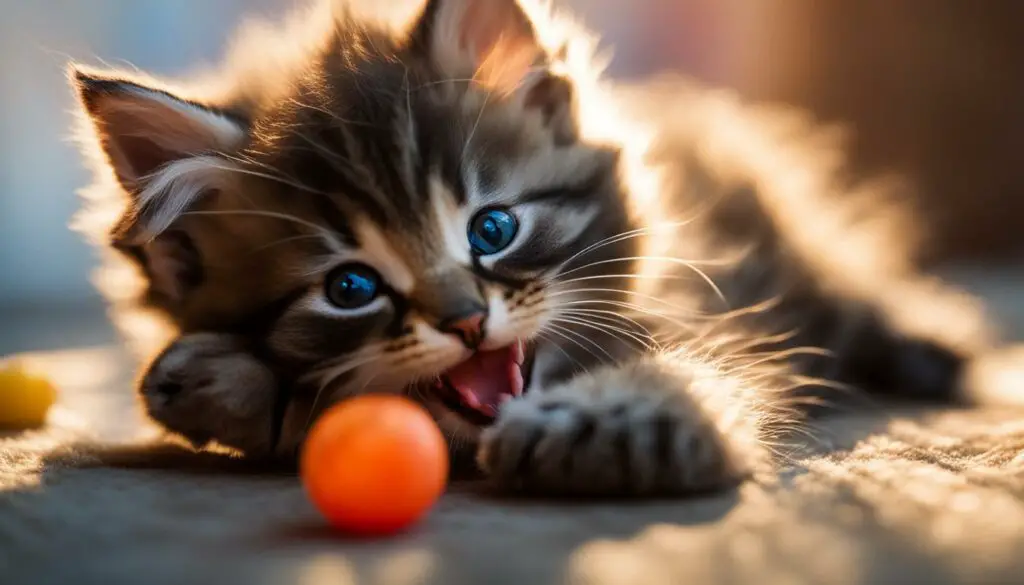
Table: Signs of Play-Induced Overstimulation
| Signs | Description |
|---|---|
| Excessive growling | Growling that is intense or continuous, indicating frustration or overstimulation. |
| Dilated pupils | The kitten’s pupils appear larger than usual, a sign of heightened arousal. |
| Flattened ears | The kitten’s ears are pressed flat against their head, indicating fear or stress. |
| Arched or puffed-up back | The kitten’s back is visibly arched or puffed up, a defensive posture in response to overstimulation. |
By paying close attention to your kitten’s behavior and responding appropriately, you can create a positive and enjoyable play environment for both you and your furry friend. Remember, patience and understanding are key when dealing with play-induced overstimulation, and with time, your kitten can learn to engage in play without becoming overwhelmed.
Differentiating Rough Play from Overstimulation
When observing kittens during play, it can sometimes be difficult to differentiate between rough play and play-induced overstimulation. Both behaviors may involve growling or other signs of aggression, making it important to pay attention to additional cues to understand the context.
Rough play typically involves playful aggression, with the kitten engaging in mock hunting behaviors like pouncing, biting, and wrestling. This behavior is usually reciprocal, with both the kitten and the playing partner participating willingly and without any signs of discomfort.
“Rough play can be a normal part of a kitten’s development and helps them practice hunting skills and socialize with other cats or humans,” explains Dr. Jane Smith, a veterinarian specializing in feline behavior.
On the other hand, play-induced overstimulation occurs when a kitten becomes overwhelmed, leading to an escalation in aggressive behavior. Signs of overstimulation may include ears turning back, dilated pupils, tense body posture, or excessive vocalization.
“It’s important to recognize these signs and intervene by redirecting the kitten’s attention to a calming activity or allowing them to take a break,” advises Dr. Smith.
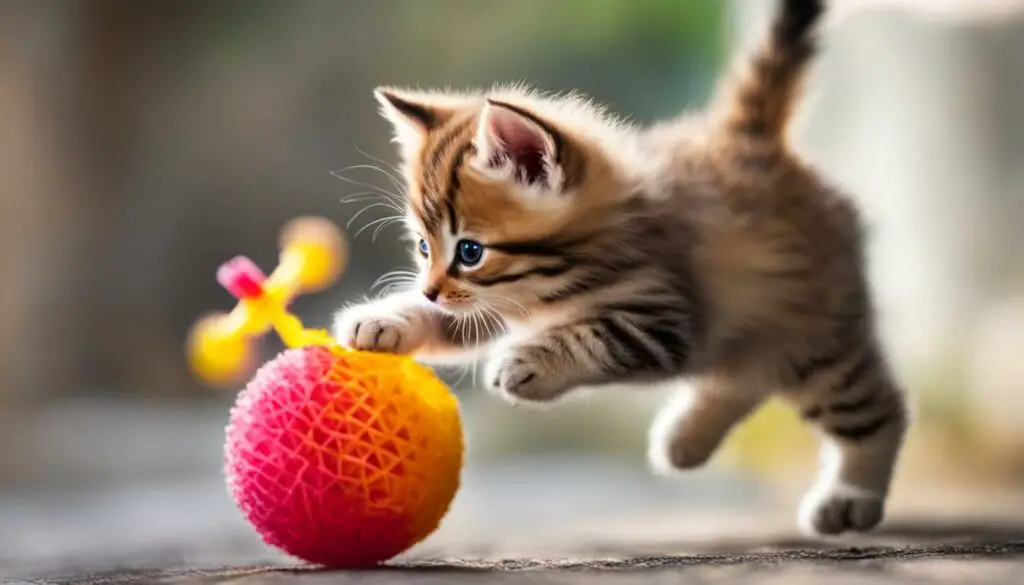
By closely observing a kitten’s body language and understanding the context of their behavior, owners can differentiate between rough play and play-induced overstimulation. This awareness allows for appropriate intervention and ensures a positive play experience for both the kitten and their human companions.
Preventing and Correcting Play-Induced Overstimulation
When it comes to dealing with play-induced overstimulation in kittens, there are several calming techniques and toys that can be effective in redirecting their behavior. By providing a variety of toys and engaging in structured play therapy, you can help prevent overstimulation and create a positive play environment for your furry friend.
One technique to calm a growling kitten is to use interactive toys that offer mental stimulation and physical activity. Toys that encourage hunting and foraging behavior, such as puzzle toys, can help redirect their focus and energy. These toys challenge the kitten to retrieve treats through varied openings, stimulating their natural instincts while providing a rewarding play experience.
In addition to interactive toys, rotating the toys available to your kitten can help keep them engaged. This prevents boredom and allows them to explore different textures, sounds, and movements. Simple household items like empty cardboard boxes or crinkly paper bags can also provide entertainment for your curious kitten.
Remember, consistency is key in correcting play-induced overstimulation. Avoid using your hands as toys and instead provide appropriate alternatives. If your kitten becomes too aggressive during play, distract them with a toy and give them a brief timeout to help redirect their behavior in a positive way.
Calming Techniques for Growling Kittens:
- Use interactive toys that offer mental stimulation and physical activity
- Rotate toys to prevent boredom and keep them engaged
- Avoid using hands as toys and provide appropriate alternatives
- Distract aggressive behavior with a toy and give a brief timeout if necessary
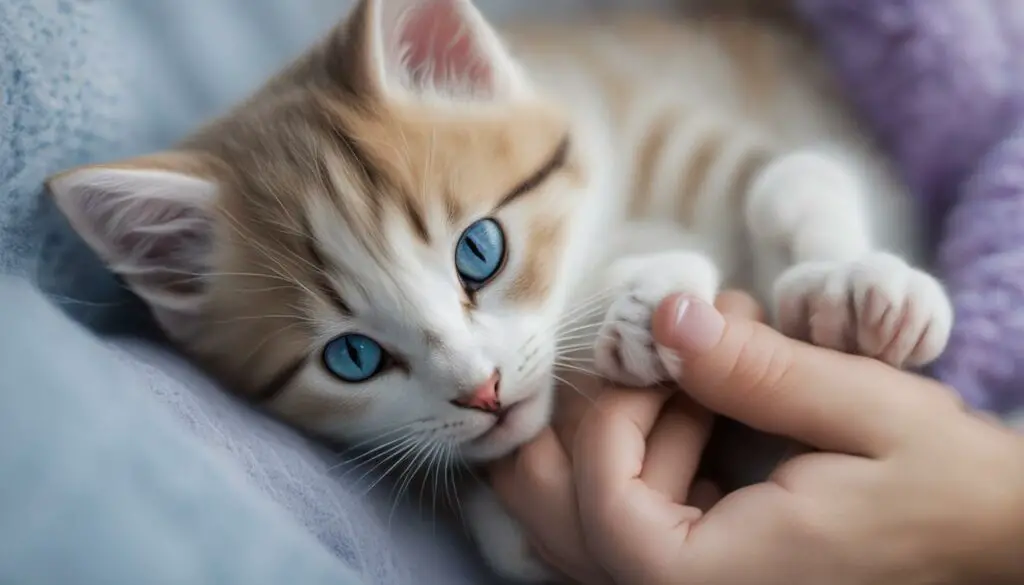
| Toy Type | Description |
|---|---|
| Interactive Puzzle Toys | Toys that challenge the kitten to retrieve treats through varied openings, stimulating their natural instincts |
| Rotating Toys | Providing a variety of toys and rotating them to prevent boredom and encourage exploration |
| Household Items | Simple items like empty cardboard boxes or crinkly paper bags can provide entertainment for curious kittens |
The Role of Interactive Puzzle Toys
Interactive puzzle toys play a crucial role in keeping kittens entertained and mentally stimulated. These toys are designed to challenge their problem-solving skills and stimulate their natural foraging behavior. By providing a rewarding and engaging play experience, interactive puzzle toys can help prevent boredom and destructive behavior.
One popular type of interactive puzzle toy is the treat-dispensing toy. These toys require the kitten to manipulate different parts or solve puzzles in order to access treats hidden inside. This not only provides mental stimulation but also encourages cats to use their natural hunting instincts, promoting a healthier and happier play experience.
Interactive puzzle toys come in various designs and difficulty levels, catering to different kittens’ needs and abilities. Some toys may have adjustable difficulty settings, allowing owners to increase the challenge as the kitten becomes more proficient. It is important to choose toys that are appropriate for the kitten’s age, size, and abilities to ensure a safe and enjoyable playtime.
| Benefits of Interactive Puzzle Toys: |
|---|
| Stimulates mental agility |
| Promotes problem-solving skills |
| Encourages natural foraging behavior |
| Provides physical exercise |
| Reduces boredom and destructive behavior |
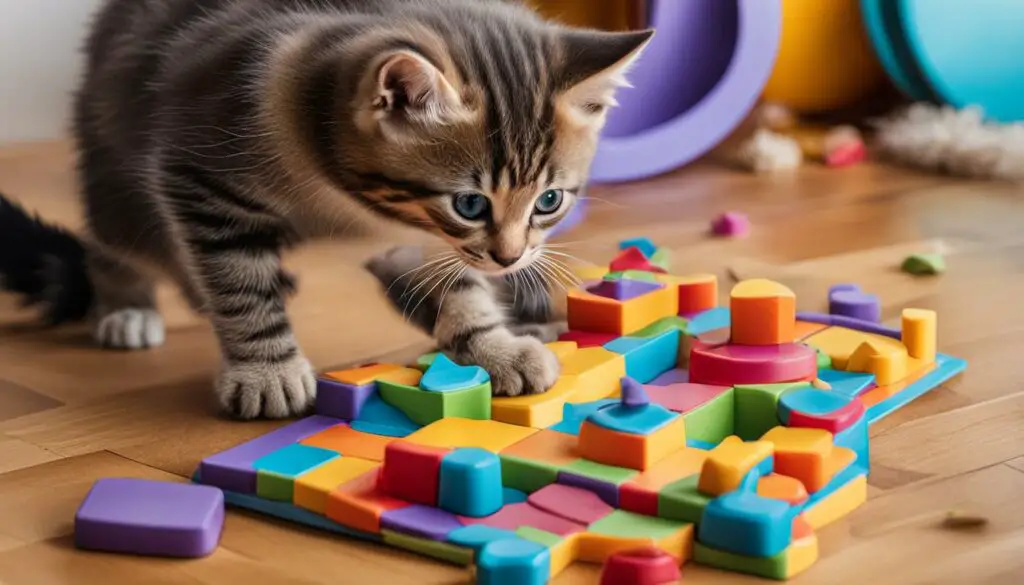
Introducing Interactive Puzzle Toys to Your Kitten
When introducing interactive puzzle toys to your kitten, start with simpler designs and gradually increase the difficulty level as they become more experienced. Show them how the toy works initially by demonstrating how to retrieve the treats. This helps them understand the purpose of the toy and encourages their curiosity.
Ensure that the toy is safe and durable, with no small parts that could be swallowed. Supervise your kitten during playtime with interactive puzzle toys to prevent any accidents or misuse. It is essential to provide a positive and rewarding experience, so praise and reward your kitten when they successfully retrieve treats from the toy.
Regularly rotate the toys to keep the play experience fresh and exciting. This prevents the kitten from getting bored and ensures that they continue to engage with the toys. By incorporating interactive puzzle toys into your kitten’s play routine, you can provide them with both mental stimulation and physical exercise, promoting their overall well-being.
Choosing the Right Interactive Fishing Pole Toys
When it comes to engaging with a growling kitten during playtime, interactive fishing pole toys can be a game-changer. These toys simulate the movements of prey, satisfying a kitten’s natural hunting instincts and providing an exciting play experience. But with so many options available, how do you choose the right fishing pole toy for your growling kitten?
Fishing Pole Toy Options
| Toy Name | Description | Benefits |
|---|---|---|
| Go Cat Cat Catcher | The Cat Catcher features a wire and a mouse-like attachment that mimics the movements of small prey. | – Provides interactive play – Stimulates natural hunting instincts – Durable and long-lasting |
| Neko Flies | Neko Flies offers a range of interchangeable attachments that mimic different types of prey, such as bugs, birds, and mice. | – Versatile play options – Engages the kitten’s senses – Encourages active play |
Both the Go Cat Cat Catcher and Neko Flies are highly recommended interactive fishing pole toys that can keep your growling kitten entertained and mentally stimulated. Remember to always supervise playtime and allow your kitten to catch and “kill” the toy at the end of each play session to satisfy their hunting instincts.
Playing with a growling kitten can be a fun and rewarding experience. By choosing the right interactive fishing pole toy, you can provide your kitten with a stimulating playtime that satisfies their natural instincts and helps redirect their energy in a positive way.
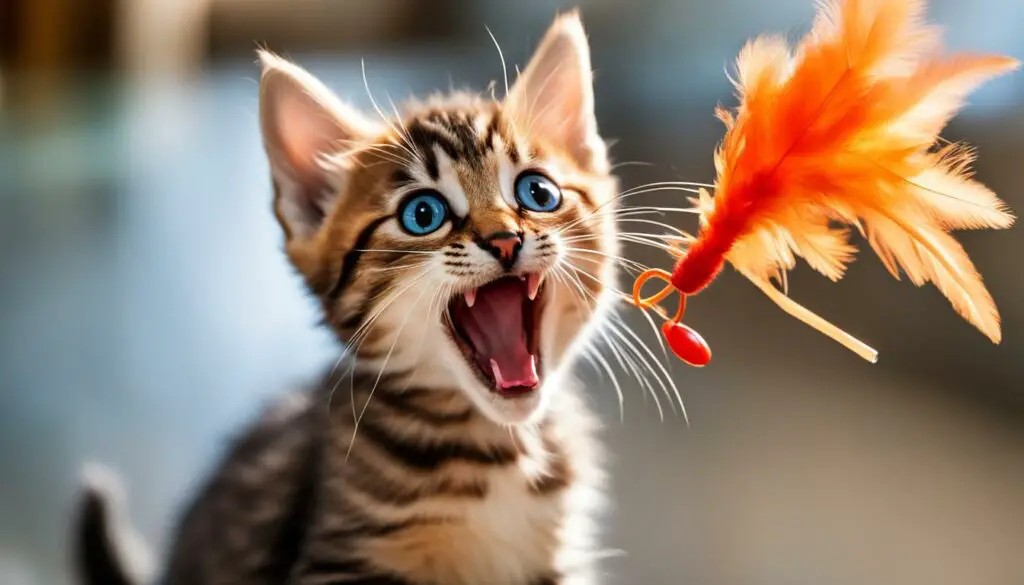
Rotating Toys for Long-Term Engagement
When it comes to keeping your kitten entertained and engaged, rotating toys is a simple yet effective strategy. Not only does it prevent your kitten from getting bored with the same toys, but it also stimulates their natural curiosity and hunting instincts. And the best part? Cat toys don’t need to be expensive to provide hours of entertainment and enrichment.
By regularly introducing new toys and rotating them every few days, you can keep your kitten’s interest piqued. This can be as simple as hiding a few toys in a box and swapping them out every few days. You’ll be amazed at how excited your kitten becomes when they discover a “new” toy. Remember, even simple household items like paper bags or toilet paper rolls can provide endless entertainment for your furry friend.
In addition to rotating toys, you can also engage your kitten with interactive puzzle toys. These toys challenge their problem-solving skills and stimulate their natural foraging behavior. Hide treats or kibble inside the puzzle toy and watch as your kitten eagerly tries to retrieve them. Just make sure to supervise your kitten during playtime to ensure they don’t accidentally ingest any small parts.
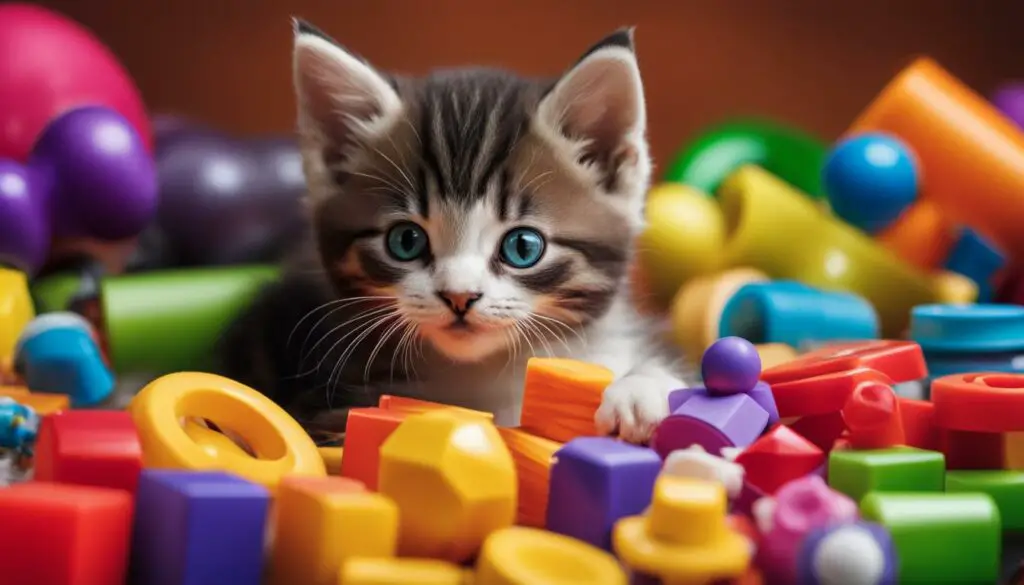
| Benefits of Rotating Toys | Tips for Rotating Toys |
|---|---|
|
|
Remember, the key is to keep your kitten engaged and entertained, and it doesn’t have to break the bank. So don’t hesitate to get creative with your toy rotation strategy, and watch as your kitten’s playtime becomes even more exciting and enriching.
Enforcing Positive Behavior during Play
When it comes to playtime with your kitten, it’s important to establish and enforce positive behavior right from the start. By doing so, you can ensure that playtime remains enjoyable and safe for both you and your furry friend. Here are some effective strategies to stop your kitten from growling at toys and redirect any play-induced overstimulation behavior:
- Provide appropriate toys: Instead of using your hands as toys, offer a variety of engaging and interactive toys specifically designed for kittens. This will help redirect their focus onto the toys and discourage any aggressive behavior towards you.
- Distract with toys: If your kitten starts growling or exhibiting aggressive behavior during play, immediately redirect their attention to an appropriate toy. This will help them understand that the toy is the acceptable target for their play energy.
- Give timeouts: If your kitten continues to exhibit play-induced overstimulation behavior despite redirection, it may be necessary to give them a timeout. This involves removing yourself and the toys from their immediate vicinity for a short period of time. This can help them calm down and understand that their actions have consequences.
Remember, consistency is key when enforcing positive behavior during play. By consistently redirecting your kitten’s behavior and providing appropriate toys, you can help them develop healthy play habits over time.
Redirecting Play-Induced Overstimulation Behavior
Play-induced overstimulation behavior can occur when a kitten becomes overly excited during playtime. They may start growling, scratching, or biting, which can be a sign of overstimulation. If you notice your kitten displaying these behaviors, here are some tips on redirecting their behavior:
- Recognize the signs: It’s important to be able to recognize the signs of overstimulation in your kitten. This can include dilated pupils, flattened ears, excessive vocalization, or aggressive body language. By identifying these signs early on, you can intervene and redirect their behavior before it escalates.
- Take a break: If you notice your kitten becoming overstimulated, take a short break from playtime. This will help them calm down and prevent any potential harm to you or other animals. Use this break to provide them with a quiet space where they can relax and decompress.
- Resume play gradually: Once your kitten has calmed down, you can gradually resume playtime. Start with slower and less intense play movements to prevent overstimulation from occurring again. Observe your kitten’s body language and adjust the play intensity accordingly.
By implementing these strategies, you can redirect your kitten’s play-induced overstimulation behavior in a positive and nurturing way, ensuring a more enjoyable play experience for both of you.
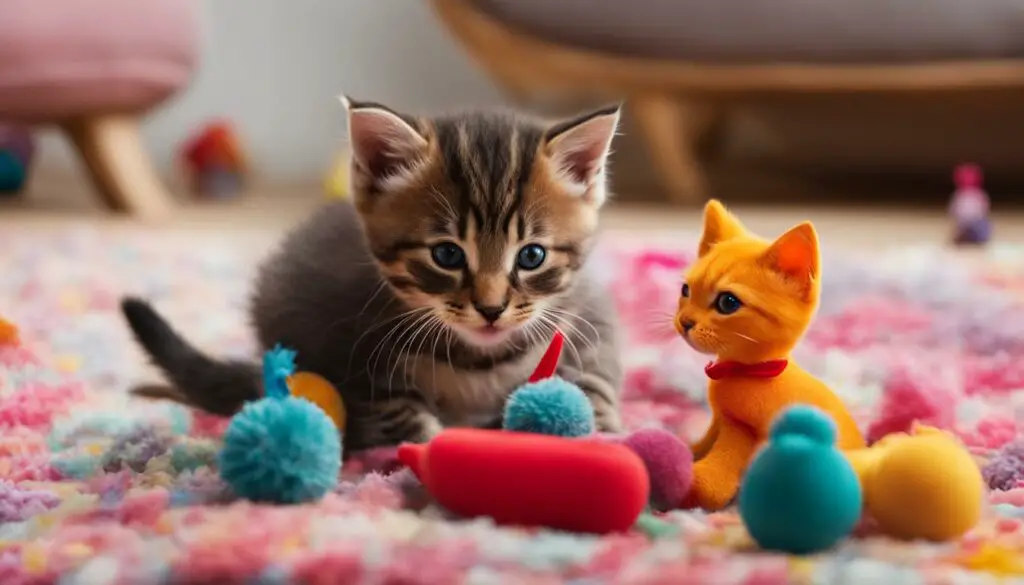
| Common Mistakes to Avoid | Effective Strategies to Try |
|---|---|
| Using hands as toys during play | Providing appropriate toys and using interactive play techniques |
| Ignoring growling or aggressive behavior | Redirecting behavior with toys and giving timeouts when necessary |
| Punishing your kitten physically | Using positive reinforcement and consistency to enforce positive behavior |
The Importance of Consistency and Avoiding Punishment
When it comes to managing kitten aggression with toys, consistency is key. By establishing a set of rules and boundaries during playtime, you can help redirect their behavior in a positive way. It’s important to avoid physical punishment, as it can lead to fear and worsen aggression. Instead, focus on understanding the underlying causes of their behavior and addressing them appropriately.
To enforce positive behavior during play, avoid using your hands as toys. Provide appropriate toys that are safe and engaging for your kitten. If your kitten displays aggressive behavior, distract them with a toy and redirect their attention. By consistently reinforcing this behavior, your kitten will learn to associate playtime with appropriate play and positive interactions.
Timeouts can also be effective in correcting play-induced overstimulation or aggression. If your kitten becomes overly aggressive or overstimulated, remove them from the play area for a brief period. This allows them to calm down and prevents the behavior from escalating further. Be consistent with the use of timeouts and ensure they are used as a learning opportunity, rather than a form of punishment.
| Key Points | Actions |
|---|---|
| Use appropriate toys | Provide a variety of toys that are safe and engaging for your kitten. Avoid using your hands as toys. |
| Distract and redirect | If your kitten displays aggressive behavior, distract them with a toy and redirect their attention. |
| Consistency is key | Establish and reinforce consistent rules and boundaries during playtime. |
| Timeouts | Use timeouts as a learning opportunity to help your kitten calm down and prevent escalation of aggressive behavior. |
Understanding Toy Aggression in Cats
Toy aggression in cats is a common behavior where they display growling, biting, and rough play when interacting with toys. If you find yourself wondering, “Why is my cat toy aggressive?” it’s important to understand the underlying reasons behind this behavior.
Cats may become toy aggressive when they feel their ownership of a prized possession is threatened. They may perceive the toy as their territory and display defensive behavior to protect it. This behavior can also stem from play aggression or territorial defensiveness.
Play aggression is often seen in kittens that are still learning hunting skills. As they play with toys, they may exhibit rough play behavior, including growling and biting. While this behavior may be a result of their natural instincts, it’s essential to guide them towards appropriate play behavior to prevent it from escalating into aggressive tendencies.
Territorial defensiveness can also contribute to toy aggression in cats. When cats feel the need to protect their belongings and space, they may become aggressive towards anyone or anything that encroaches on their territory. Changes in the household environment, the presence of strays, or sheltered cats can trigger territorial defensiveness and exacerbate toy aggression.
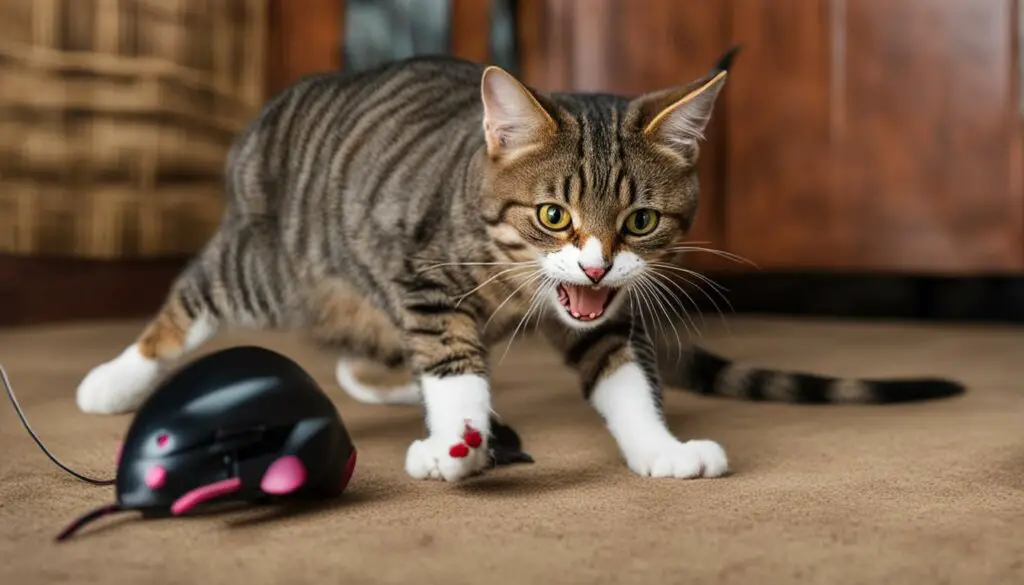
Understanding the reasons behind toy aggression in cats is crucial for creating a safe and fulfilling play environment. By recognizing the underlying causes and addressing them appropriately, owners can encourage healthy play behavior and minimize aggression. Using positive reinforcement and providing enriched environments can help cats feel secure and reduce toy aggression.
Play Aggression and Its Causes
Play aggression in kittens and cats can be attributed to various factors, including poor training, lack of stimulation, and the natural instinct to practice hunting skills. Understanding these causes can help owners address the behavior and promote healthier play experiences.
Poor training can contribute to play aggression in cats. If a kitten hasn’t been taught appropriate play behavior from an early age, they may not understand the boundaries of play and can become overly rough or aggressive. It is important for owners to provide guidance and redirect the kitten’s behavior when it becomes too aggressive, using appropriate toys rather than their hands.
Lack of stimulation is another common cause of play aggression. Cats are curious creatures and need mental and physical stimulation to keep them engaged and prevent boredom. Without adequate stimulation, a cat may resort to rough play or aggressive behavior as a way to release pent-up energy. Providing interactive toys, puzzle toys, and regular play sessions can help alleviate this issue.
It’s important to note that play aggression is more commonly observed in kittens, as they are still learning proper hunting skills and may not have fully developed impulse control. As cats grow older, they tend to outgrow this behavior if properly trained and stimulated. However, if play aggression persists in adult cats, it may be necessary to consult with a veterinarian or animal behaviorist for further guidance.
| Cause | Explanation |
|---|---|
| Poor Training | Kittens not taught appropriate play behavior may exhibit rough or aggressive play. |
| Lack of Stimulation | Cats need mental and physical stimulation to prevent boredom and excessive aggression. |
| Learning Hunting Skills | Kittens may engage in play aggression as they practice their hunting instincts. |
By addressing the underlying causes of play aggression, owners can provide a safe and enjoyable play environment for their kittens and cats. Through positive reinforcement, proper training, and providing ample mental and physical stimulation, cats can engage in healthy play behavior and strengthen the bond with their owners.
Territorial Defensiveness and Its Impact on Toy Aggression
Territorial defensiveness is a natural behavior in cats as they are instinctively driven to protect their territory. This behavior can extend to their belongings, including toys. When a cat perceives an encroachment on its territory, it may display toy aggression as a way to assert control and protect its resources.
Strays and sheltered cats are more likely to exhibit territorial defensiveness, as they may have had to fight for resources in the past. Changes in the household environment, such as the addition of a new pet or rearrangement of furniture, can also trigger territorial behavior in cats. Understanding the underlying causes of territorial defensiveness can help address the issue and create a harmonious environment for both the cat and its owner.
To prevent toy aggression resulting from territorial defensiveness, it is important to provide each cat with its own toys and play areas. This helps minimize competition and reduces the likelihood of conflict. Additionally, creating a secure and stimulating environment for the cat, with designated resting spots and high perches, can alleviate feelings of territorial insecurity and promote a sense of ownership over its space.
It is crucial to approach territorial defensiveness and toy aggression with patience and understanding. Punishment should never be used as it can exacerbate the problem and erode the bond between the cat and its owner. Instead, positive reinforcement and redirection techniques can be employed to encourage appropriate behavior and minimize territorial disputes.
| Signs of Territorial Defensiveness: | Ways to Address Territorial Defensiveness: |
|---|---|
|
|
Understanding and addressing territorial defensiveness is crucial for managing toy aggression in cats. By creating a safe and stimulating environment, providing individual resources, and utilizing positive reinforcement techniques, owners can help their cats feel secure and reduce the likelihood of toy-related conflicts.
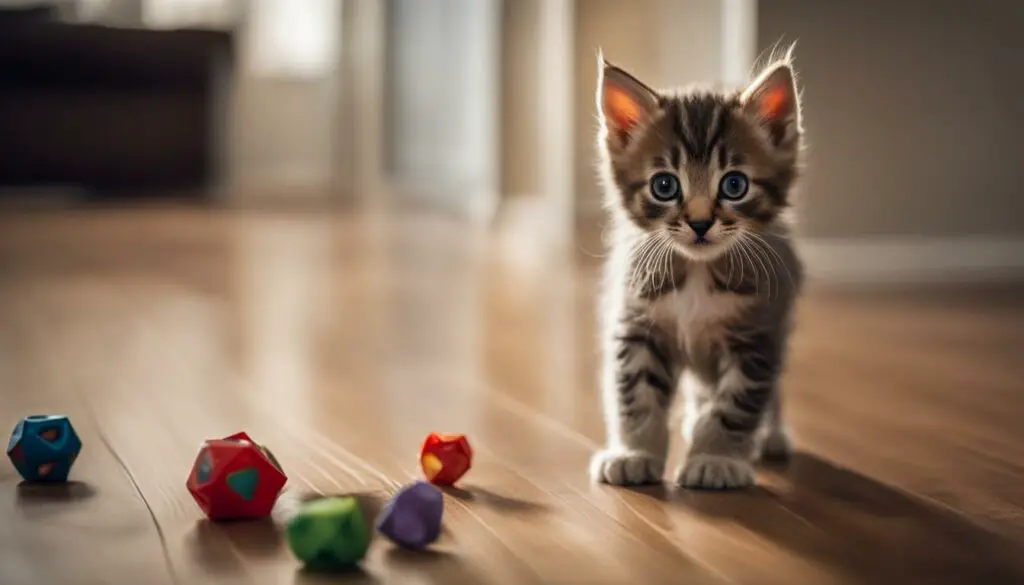
Conclusion
I hope this guide has provided you with valuable insights into managing a growling kitten and addressing toy aggression in cats. Understanding the reasons behind your kitten’s behavior is the first step in creating a positive play environment. Remember to provide appropriate toys and engage in structured play therapy to channel their energy and stimulate their natural instincts.
To calm a growling kitten, try using soothing techniques like gentle petting or offering a treat. Redirecting their aggression towards appropriate toys can also be effective. Consistency is key when correcting play-induced overstimulation or aggressive behavior, but it is important to avoid physical punishment, as it can worsen aggression.
Remember, toy aggression in cats can be a result of play aggression or territorial defensiveness. By providing a secure and stimulating environment, as well as addressing any underlying issues, you can help foster healthy play behavior in your kitten. With love, patience, and understanding, you can ensure a delightful play experience for both you and your adorable furry companion.
FAQ
Why does my kitten growl while playing with toys?
Growling behavior while playing with toys is normal and playful behavior for kittens. It is their way of expressing excitement and engaging in interactive play.
How can I ensure a positive play experience for my kitten?
Understanding your kitten’s growling behavior and recognizing the signs of overstimulation can help ensure a positive play experience. Providing a variety of toys, engaging in structured play therapy, and avoiding using hands as toys can contribute to a safe and enjoyable playtime for both you and your kitten.
What are the signs of play-induced overstimulation?
Play-induced overstimulation may manifest as ankle grabbing, scratching, or biting. It is important to recognize these signs to prevent any potential harm to you or other animals.
How can I differentiate between rough play and play-induced overstimulation?
Distinguishing between rough play and overstimulation can be challenging. Observing your kitten’s body language, such as ears turning back or growling, can indicate when play has escalated into overstimulation. It is important to take a break and redirect their behavior in a positive way if overstimulation occurs.
How can I prevent and correct play-induced overstimulation?
Providing a variety of toys and engaging in structured play therapy can help prevent and correct play-induced overstimulation. Regular play sessions, use of interactive toys, and rotating toys can keep your kitten entertained and mentally stimulated.
What role do interactive puzzle toys play in a kitten’s playtime?
Interactive puzzle toys can be effective in keeping kittens entertained and mentally stimulated. These toys challenge your kitten to retrieve treats through varied openings, stimulating their natural foraging behavior and providing a positive play experience.
How can I choose the right interactive fishing pole toys for my kitten?
Interactive fishing pole toys, such as the Go Cat Cat Catcher or Neko Flies, can help engage kittens in play and satisfy their hunting instincts. Properly mimicking prey movements while using these toys can enhance the play experience for your kitten.
Is it necessary to rotate toys for my kitten?
Yes, rotating toys by not keeping the same toys out all the time can prevent your kitten from getting bored. Additionally, cats can find enjoyment in simple household items, such as grocery bags or toilet paper rolls, so expensive toys are not always necessary.
How can I enforce positive behavior during play?
It is crucial to avoid using hands as toys during play and instead provide appropriate toys for your kitten. Distracting your kitten with a toy when they display aggressive behavior and giving them a timeout when necessary can help redirect their behavior in a positive way.
How important is consistency in correcting play-induced overstimulation or aggressive behavior?
Consistency is key when correcting play-induced overstimulation or aggressive behavior. Physical punishment should never be used, as it can lead to fear and worsen aggression. Understanding the underlying causes and addressing them is more effective in modifying behavior.
What is toy aggression in cats?
Toy aggression in cats occurs when they feel their ownership of a prized possession is threatened. Growling, biting, and excessive rough play are common signs of toy aggression. This behavior may stem from play aggression or territorial defensiveness.
What causes play aggression in kittens?
Play aggression can be a result of unspent energy, boredom, or poor training. Kittens may engage in play aggression as they are still learning hunting skills. Lack of mental and physical stimulation can also contribute to play aggression in older cats.
How does territorial defensiveness impact toy aggression?
Cats can display territorial defensiveness, feeling the need to protect their belongings and space. This can lead to toy aggression when they perceive an encroachment on their territory. Strays, sheltered cats, and changes in the household environment can contribute to this behavior.

